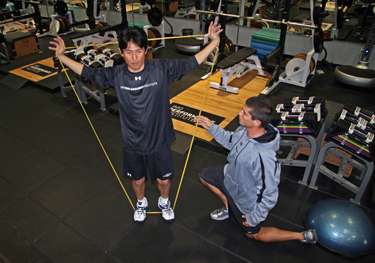
When you’ve climbed your sport’s highest mountain, you have two choices: lament the absence of a bigger goal or embrace the totality of what it took to reach that summit and then work your butt off to polish that rare package of skills and aptitude.
Takahiro Omori the 2004 Bassmaster Classic winner — has chosen the latter. That’s why he’s enrolled in IMG Academies’ programs for the past seven years. Located in Bradenton, Fla., the 400-acre multi-sport training complex offers coaching and tailored programs for multinational athletes from youth to pros.
Bass fishing was a first, but Trevor Moawad, director of the IMG Performance Institute, said he insisted on treating Tak like any other athlete from day one. “The Bassmaster Elite Series is the highest level in our industry,” Omori says. “If you want to compete against the best of the best on all different types of water, you have to prepare yourself not only with the physical part, but mental conditioning, nutrition — the whole thing.
Just like you would get the best boat, engine, rods, reels and line, you have to train yourself to get better.” Let’s look at why a professional bass angler spends many hours with the same trainers that work with sports stars like Maria Sharipova and Eli Manning. In the gym where Tak’s framed Yamaha jersey shares wall space with Manning’s, IMG trainer Alex Cohen teaches exercises that benefit a bass pro’s actions and those that meld with his lifestyle. For example, doing squats on a bosu ball — a half sphere with a flat surface for standing — improves the balance Tak needs in rough water. “It’s just (beneficial) in all areas of sports to have good core stability — a good base,” Cohen said. “For a professional angler, after a long day on the water, this stability will help them focus on what they’re doing, as opposed to worrying about their back getting tired or their shoulder feeling fatigued.” Next, Cohen gives Tak an elastic band that he stretches overhead while standing on the bottom edge. This resistance exercise, along with the foam bar upon which he extends and contracts his body present easy, yet effective routines he can practice on the road during tournament and promotional travel. Now, despite such training, even well conditioned athletes can suffer wear-and-tear injuries.
After years of power fishing strain, tendonitis in his left hand means Tak now has trouble gripping his reels. He undergoes muscular relaxation therapy with IMG’s Head Athletic Trainer, Patrick Tanner, but he’s switching to left-handed reels for at least part of the 2011 season. Prepping Tak for the change and helping him prevent other injuries is paramount for IMG. “Two thousand casts a day must be the most repetitive movement in any sport — especially when you talk about four or five days in a row, week after week,” Tanner said. “That’s a very isolated repetitive movement with the upper wrist, elbow and shoulder. “Also, standing for eight hours a day, the pounding while driving a boat, sitting in an ergonomically incorrect seat, standing with your foot on the trolling motor — that’s a nightmare for someone looking at ergonomics and posture.
That’s really why Tak’s here working out. The stronger the core, the stronger the legs, the more he can control his posture and those movements. He’s always going to cast and he’s always going to sit and stand on a boat, but the stronger his body is, the less chance he’ll be injured.” Implementing such a drastic alteration is understandably concerning for Tak: “I’m not used to this — I’ve never fished a tournament with a left-hand reel.
Technically, this is the biggest change I’ve made in my career. It changes the way you hold the rod, the way you set the hook, the way you grab the fish. I’m not 100 percent sure this is going to work.” That’s where mental toughness comes into play. IMG has worked extensively on this part of Tak’s game. We’ll look at his progress in Part 2.

